Related Research Articles
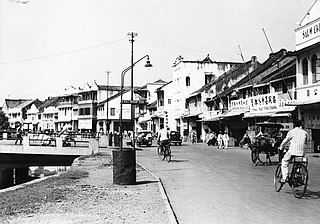
Batavia was the capital of the Dutch East Indies. The area corresponds to present-day Jakarta, Indonesia. Batavia can refer to the city proper or its suburbs and hinterland, the Ommelanden, which included the much larger area of the Residency of Batavia in the present-day Indonesian provinces of Jakarta, Banten and West Java.

Depok is a landlocked city in West Java province. It is located directly south of Jakarta within the Jakarta Metropolitan Area in Indonesia. It has an area of 199.91 km2. It had a population of 1,738,600 at the 2010 census and 2,056,400 at the 2020 census; the official estimate as at mid 2022 was 2,123,349, resulting in a density of 10,621.5 people per km2. Depok was declared as a separate city on 20 April 1999, having previously been part of Bogor Regency. It constitutes the second most populous suburban city in Indonesia, and the tenth most populous suburban city globally.
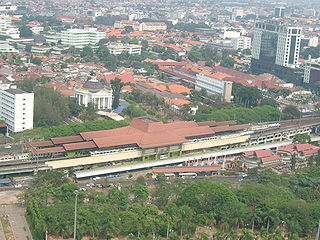
Gambir is a district in the administrative city of Central Jakarta, Indonesia.. It is characterized by many historic buildings from the colonial era. It hosts some of the foremost political and learning/tourism features of the capital. The Merdeka Palace, the National Museum, the headquarters of the Indonesian Scout Movement and the Merdeka Square are among these.
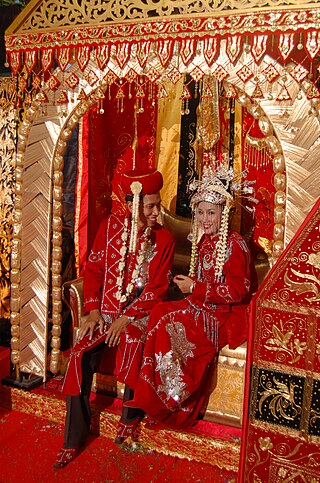
Betawi people, or Batavians, are an Austronesian ethnic group native to the city of Jakarta and its immediate outskirts, as such often described as the native inhabitants of the city. They are the descendants of the people who inhabited Batavia from the 17th century onwards.

The Mardijker people refers to an ethnic community in the Dutch East Indies made up of descendants of freed slaves. They could be found at all major trading posts in the East Indies. They were mostly Christian, of various ethnicity from conquered Portuguese and Spanish territories, and some with European ancestry. They spoke Mardijker Creole, a Portuguese-based creole, which has influenced the modern Indonesian language.

Mardijker is an extinct Portuguese-based creole of Jakarta. It was the native tongue of the Mardijker people. The language was introduced with the establishment of the Dutch settlement of Batavia ; the Dutch brought in slaves from the colonies they had recently acquired from the Portuguese, and the slaves' Portuguese creole became the lingua franca of the new city. The name is Dutch for "freeman", as the slaves were freed soon after their settlement. The language was replaced by Betawi creole Malay in Batavia by the end of the 18th century, as the Mardijker intermarried and lost their distinct identity. However, around 1670 a group of 150 were moved to what is now the village and suburb of Tugu, where they retained their language, there known as Papiá, until the 1940s.

Kemayoran is a district of Central Jakarta, Jakarta in Indonesia. It was best known for the former Kemayoran Airport and it has been transforming as a new central business district. As of 2023, it consists of numerous four and five star hotels, restaurants, premium office towers, hospitals as well as shopping and entertainment centers. Kemayoran is also home to the Jakarta Fair, the largest and longest fair in Southeast Asia that attracts more than 4 million visitors annually.

Sawah Besar is a district (kecamatan) of Central Jakarta, Indonesia. Its neighborhoods are among the most historic, containing the 1820-established Pasar Baru, the new colonial city – Weltevreden – and the old course of the Ciliwung river. Landmarks include the Lapangan Banteng, the government's 19th century-built, low-rise A.A. Maramis Building and its high palmed-lawned vista, and Jakarta Cathedral.
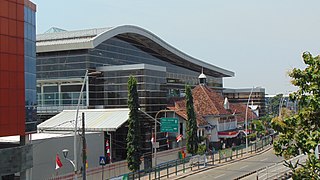
Jatinegara is one of the districts of the administrative city of East Jakarta, Indonesia. The name also refers to the larger, historic area of the colonial town of Meester Cornelis. Established in the 17th century, Jatinegara is one of the oldest areas in Jakarta, and contains a number of buildings from the colonial period.
Koja is a subdistrict of North Jakarta, Indonesia. It is known as the location of Kampung Tugu, a historic Portuguese-influenced neighborhood in North Jakarta.

There are 1,340 recognised ethnic groups in Indonesia. The vast majority of those belong to the Austronesian peoples, with a sizeable minority being Melanesians. Indonesia has the world's largest number of Austronesians and Melanesians.

The Portuguese were the first Europeans to establish a colonial presence in the Indonesian Archipelago. Their quest to dominate the source of the spices that sustained the lucrative spice trade in the early 16th century, along with missionary efforts by Roman Catholic orders, saw the establishment of trading posts and forts, and left behind a Portuguese cultural element that remains in modern-day Indonesia.

The Dutch East Indies, also known as the Netherlands East Indies, was a Dutch colony that became Indonesia in 1949. Based on the Anglo-Dutch Treaty of 1824, the Dutch have ceded the Dutch Malacca to Britain, which was before a governorate of the Dutch East Indies. This has consolidated modern-day rule to Malacca state of Malaysia. The Dutch East Indies was formed from the nationalised trading posts of the Dutch East India Company, which came under the administration of the Dutch government in 1800.

Indo people are a Eurasian people of mixed Indonesian and European descent. Through the 16th-18th centuries, they were known by the name Mestiço. To this day, they form one of the largest Eurasian communities in the world. The early beginning of this community started with the arrival of Portuguese traders in South East Asia in the 16th century. The second large wave started with the arrival of the Dutch East India Company (VOC) employees in the 17th century and throughout the 18th century. Even though the VOC is often considered a state within a state, formal colonisation by the Dutch only commenced in the 19th century.
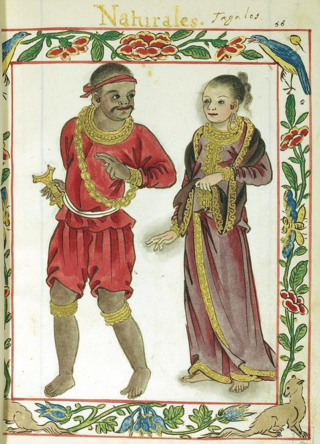
The maharlika were the feudal warrior class in ancient Tagalog society in Luzon, the Philippines. They belonged to the lower nobility class similar to the timawa of the Visayan people. In modern Filipino, however, the word has come to refer to aristocrats or to royal nobility, which was actually restricted to the hereditary maginoo class.
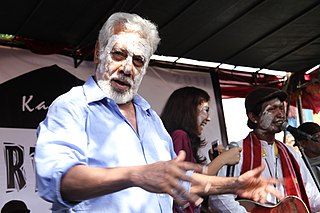
Portuguese Indonesians are native Indonesians with Portuguese ancestry or have had adopted Portuguese customs and some practices such as religion.

The Thousand Islands are a chain of islands to the north of Jakarta's coast. It forms the only regency of Jakarta, the capital of Indonesia. It consists of a string of 342 islands stretching 45 km (28 mi) north into the Java Sea at West Jakarta Bay and in fact north of Banten Province. Pramuka Island is the regency seat. The islands, along with North Jakarta, is the only two regions in Jakarta with a coastline.

Batavia Castle was a fort located at the mouth of Ciliwung River in Jakarta. Batavia Castle was the administrative center of Dutch East India Company (VOC) in Asia.

Kampung Tugu is a historical neighborhood located in the northwestern Jakarta in the island of Java. Kampung Tugu grew from the land granted by the government of the Dutch East Indies to the converted Mardijker people in the 17th century. From this land, a Christian settlement grew and developed its own culture. Kampung Tugu is one of the oldest Christian neighborhoods in the western part of Indonesia. Today, the Christian neighborhood of Kampung Tugu is part of the Administrative Village of Tugu in Koja Subdistrict of North Jakarta, Indonesia.
The Battle of Penfui took place on 9 November 1749 in the hillside of Penfui, near modern Kupang. A large Topass army was defeated by a numerically inferior Dutch East India Company force following the withdrawal of the former's Timorese allies from the battlefield, resulting in the death of the Topass leader Gaspar da Costa. Following the battle, both Topass and Portuguese influence on Timor declined, eventually leading to the formation of a boundary between Dutch and Portuguese Timor which precipitated into the modern border between West Timor and East Timor.
References
- ↑ Choudhury, Manilata (2014). "The Mardijkers of Batavia: Construction of a Colonial Identity (1619-1650)". Proceedings of the Indian History Congress. 75 (Platinum Jubilee): 901–910. JSTOR 44158475.
- ↑ Jarnagin, Laura (2011). Portuguese and Luso-Asian Legacies in Southeast Asia, 1511-2011: The making of the Luso-Asian world, intricacies of engagement. Institute of Southeast Asian Studies. pp. 136–137. ISBN 9789814345255.
- ↑ Simbolon, Parakitri Tahi. Menjadi Indonesia , hal. 462, Cet. ketiga, Januari 2007. Penerbit Buku Kompas, Jakarta. ISBN 979-709-264-X. Diakses 24 September 2010.
- ↑ East of Bali: from Lombok to Timor - Colonial Kupang